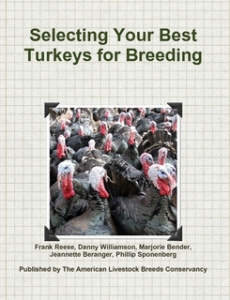
Breed Facts
Status:
Watch
Use:
Meat
Egg Color:
Pale cream to medium brown with spotting
Egg Size:
Large
Market Weight:
Male Young – 23 lbs. Mature – 28 lbs.
Female Young – 14 lbs. Mature 18 lbs.
Temperament:
Highly dependent on socialization and selection by breeder; some select for aggressive, others generally docile
Characteristics:
Can and likes to fly; can be broody; does well in cold weather.
NARRAGANSETT TURKEY
The Narragansett turkey is named for the sandy Narragansett Bay in Rhode Island, where the variety was developed. It descends from the domestic turkeys – possibly Norfolk Blacks – brought to America by English and European colonists beginning in the 1600’s. Improved and standardized for production qualities, the Narragansett became the foundation of the turkey industry in New England. Though it was valued across the country, it was especially important in Rhode Island and Connecticut. The American Poultry Association recognized the Narragansett in 1874.
According to an 1872 account, it wasn’t uncommon to find flocks of one to two hundred birds – the product of a breeder flock of a dozen hens. Little supplemental feed was given to the turkeys. Instead, they ranged for grasshoppers, crickets, and other insects. Farmers raising the turkeys were aware of the benefits of genetic selection and raised young toms that weighed between 22 to 28 pounds and hens that were 12 to 16 pounds.
While the Narragansett was never as popular as the Bronze variety, it was widely known in the Midwest and mid-Atlantic states as well as New England. Interest in the Narragansett began to decline in the early 1900s as the popularity of Standard Bronze turkeys grew. The Narragansett wasn’t used for commercial production for decades until the early 21st century when renewed interest in biological fitness, survivability, and superior flavor captured consumer interest and created a growing market niche.
The Narragansett color pattern contains black, gray, tan, and white. Its pattern is similar to that of the Bronze, with steel gray or dull black replacing the coppery bronze. White wing bars are the result of a genetic mutation that removes the bronze coloration and isn’t known outside the United States. The Narragansett’s beak is horn colored, its head is red to bluish-white, and its beard is black. The shanks and feet are salmon-colored. The standard weight for young hens is 14 pounds and toms are 23 pounds. However, since the Narragansett hasn’t been selected for production attributes, including weight gain, for years, many birds may be smaller than the standard. Careful selection for good health, ability to mate naturally, and production attributes will return this variety to its former stature.
Narragansett turkeys have traditionally been known for their calm disposition, good maternal abilities, early maturation, egg production, and excellent meat quality. As recently as 50 years ago, they were well regarded for production qualities. This historic variety, unique to North America, merits evaluation for production in sustainable agriculture systems. The Narragansett turkey would make a useful and beautiful addition to the family farm.
Did you know:
Heritage breeds are being raised on more than 4,000 farms, ranches, and backyards across America. Still, new breeders must be recruited to protect and expand rare livestock and poultry populations. America’s farmers are aging; future generations of breeds need future generations of breeders. That’s why Livestock Conservancy microgrants now include a Youth Division to encourage tomorrow’s breed stewards. Click here to invest in the future with a gift today.
You may be interested in…

Breed Facts
Status:
Watch
Use:
Meat
Egg Color:
Pale cream to medium brown with spotting
Egg Size:
Large
Market Weight:
14 -23 lbs
Temperament:
Highly dependent on selection by breeder, Some select for aggressive, others docile
You may be interested in…




